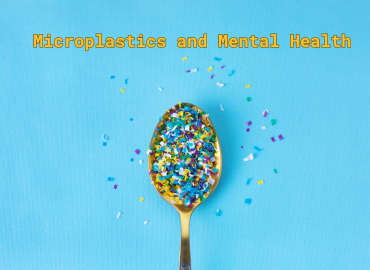Microplastics and Mental Health
Microplastics are a byproduct of plastics breaking down. A microplastic is defined as a bit of plastic under 5 mm around, about the size of a pencil eraser. There are many types of microplastics. Here are some of those:
− Microbeads that are manufactured for use in beauty products such as eyeshadow and skin scrubs
− Resin pellets used in making glass
− Synthetic clothing, particularly acrylic and polyester, that release particles into the air, onto surfaces, and into washing water.
− Tires that shed particles onto the ground and into purification systems − Plastics used for abrasive surfaces in manufacturing
− Residue from synthetic turf
Microplastics get into the air, food, building materials, fabric, cleaning products, hygiene products, and general dust and debris. Microplastics can also be found in water, whether that is ocean water, fresh water in lakes and rivers, as well as bottled water and tap water. Why is that the case?
Some factors that break down plastic and make microplastics are:
− Heat
− Friction
− Chemical compounds like acetone
− Bacterial enzymes
− Synthetic enzymes
− Fungal enzymes
− Time, that breaks down all things
Results on the effects of microplastics on humans are limited. We have data from a study on mice published in the International Journal of Molecular Science that paints a concerning picture. Small amounts of microplastics were administered to the mice in drinking water to collect data.
Exposure to microplastics has shown the following effects in mice:
− Anxiety responses
− Paranoia responses
− Cognitive decline with markers of dementia
− Neuroinflammation
− Altered neurotransmitters
− Altered immune markers
− Altered behavior as a response to neurological changes
We may soon have more conclusive data on how microplastics effect the human body. Microplastics have been found in human tissues like the kidneys, liver, and placenta, as well as bodily fluids like saliva and blood.
There are some strategies you can use to minimize your consumption of microplastics. Avoid reusing single-use plastics for your food, like drink containers. Avoid heating things in plastic, especially bottles and items for children. Try glass, silicone, or ceramic. Don’t use plastic cutting boards. Frequent friction from sharp objects loosens plastic particles and transfers them into food. Use wood cutting boards instead. Decrease your intake of water in plastic bottles. Consider steel or glass bottles. You can use an air purifier in your home and a water filter for your taps or attached to a pitcher. Watch your consumption of seafood. A high volume of microplastics finds their way to the ocean and are consumed by sea animals.
We continue to stay on top of developments in medical science so that we can provide the best care in our power to our patients and their loved ones. To find out more about our services, contact us anytime on our website or call (585) 442-6960.




